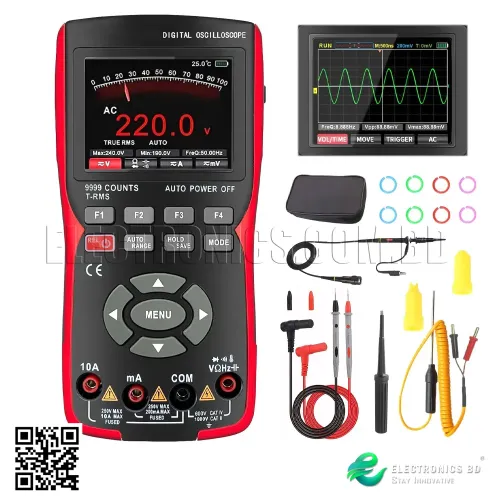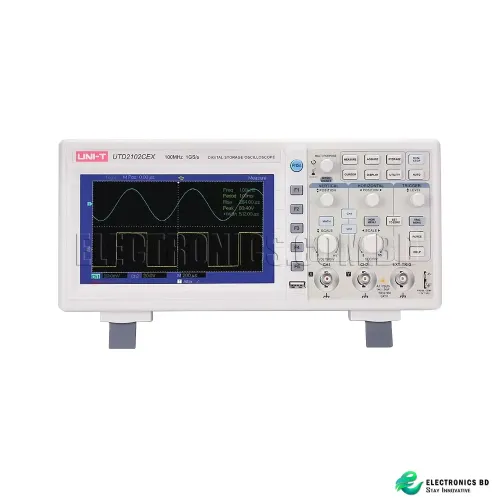Soil Tester Project
- 3D printers & CNC
- Accessories
- Active Components
- All Departments
- CNC Accessories
- Electrical Accessories & IOT
- Latest
- Oscilloscope
- Passive Components
- Projects
- SMD Components
- Socket, Port & Jacks
- Sound Systems
- Drones & RC Hobby
- Sale
Your shopping cart is empty!
Product Description
Soil Moisture and pH Sensor Based on Arduino for Soil Testing
As agriculture evolves with modern technology, understanding soil health has become crucial for optimizing crop production. The "Soil Moisture and pH Sensor" project based on Arduino allows farmers, gardeners, and hobbyists to monitor the critical parameters of soil, such as moisture and nutrient content (NPK), to ensure optimal conditions for plant growth. This project leverages sensors and Arduino to create an efficient and accurate system for soil testing.
In this blog, we will explore the components, their functions, and how this project helps analyze soil health.
Project Overview
The project utilizes an Arduino Uno R3 as the main controller, working with a Soil NPK Sensor, a TFT LCD Display, and additional components like a Buzzer Sensor to build a comprehensive soil testing system. This system monitors the soil’s nitrogen (N), phosphorus (P), and potassium (K) levels, along with its moisture content. The data is displayed in real time on the TFT screen, offering a user-friendly interface for immediate results.
This project not only provides valuable insight into soil health but also helps farmers and gardeners make informed decisions regarding irrigation, fertilization, and crop management.
Components Used
Here are the key components used in this project:
Arduino Uno R3 with Cable
- The heart of the project, Arduino Uno, acts as the controller. It processes data from the sensors and manages the system's outputs. The cable is used for programming and power supply.
VMS-3002-TR-NPK-N01 Soil NPK Sensor
- This sensor is used to measure the essential nutrients in the soil: nitrogen (N), phosphorus (P), and potassium (K). These are critical for plant health, and their balance ensures optimal growth conditions.
3.5 Inch 480x320 TFT LCD Display (ILI9486)
- The display serves as the primary interface for the user. It shows real-time data, including the readings from the soil moisture and NPK sensor. Its high resolution (480x320) provides clear and easy-to-read information.
Electric Cable Wire Dual Line Red Black Wiring Cable (23/076)
- This wire is used to connect various components within the project. The dual-line wiring ensures a stable connection and efficient power distribution between the sensors and the Arduino.
10k Ohm Resistors (5 PCS)
- Resistors are used to limit the current in the circuit and protect the sensors and other delicate components from electrical damage.
Buzzer Sensor (5V)
- The buzzer acts as an alert mechanism. If the soil moisture or NPK levels fall outside the acceptable range, the buzzer will sound to notify the user.
Working Principle
The Soil Moisture and pH Sensor project functions by collecting data from the soil through the NPK sensor and the moisture sensor. The Arduino Uno reads the input from these sensors and processes the data to determine the soil's current condition. The TFT display shows real-time information, making it easier for the user to monitor soil parameters instantly.
Soil Nutrient Detection (NPK)
- The NPK sensor detects the concentration of nitrogen, phosphorus, and potassium in the soil. These nutrients are vital for plant growth. Nitrogen is crucial for leaf growth, phosphorus helps in root development, and potassium supports overall plant health and disease resistance.
Soil Moisture Detection
- The moisture sensor measures the amount of water in the soil. This information is crucial for ensuring that plants get the right amount of water. Excessive moisture can cause root rot, while insufficient water can lead to wilting.
Data Display
- The data collected from the sensors is displayed on the TFT LCD screen in real-time. This allows users to immediately see if the soil conditions are optimal or if any adjustments need to be made in terms of irrigation or fertilization.
Buzzer Alert System
- The buzzer serves as a notification tool. If the soil moisture drops below or rises above a certain threshold or if the NPK levels are imbalanced, the buzzer will sound an alert. This feature adds an extra layer of convenience, allowing users to be aware of critical conditions even if they are not constantly monitoring the display.
Applications of the Soil Moisture and pH Sensor
This project can be applied in various fields, especially in agriculture and gardening, where soil health is crucial for crop production and plant growth. Here are some practical applications:
Precision Agriculture
- Farmers can use this system to ensure that crops are receiving the right amount of nutrients and water. This allows for better management of resources, reducing waste and increasing crop yields.
Gardening and Landscaping
- Gardeners can monitor the soil conditions of their plants, ensuring they are getting the proper care. The system helps in maintaining the right soil moisture levels and providing the necessary nutrients for flowers, vegetables, or shrubs.
Environmental Monitoring
- This system can be used in research and environmental monitoring to study soil quality in different regions, helping researchers understand soil erosion, nutrient depletion, and other environmental issues.
Automated Irrigation Systems
- The data from the soil moisture sensor can be integrated into an automated irrigation system. When the soil moisture drops below a specific threshold, the system can trigger an irrigation mechanism to provide water to the soil.
Benefits of the Project
The Soil Moisture and pH Sensor project brings several advantages for users:
Accurate and Real-time Data
- This project provides precise soil measurements in real-time, allowing users to take immediate action if the soil conditions are not optimal.
Cost-effective
- By using affordable components like the Arduino Uno and sensors, this project is cost-effective and accessible for both hobbyists and professionals.
Efficient Resource Management
- With the ability to measure moisture and nutrient levels, users can efficiently manage water and fertilizer use, leading to more sustainable practices in agriculture and gardening.
Customizable
- The project can be expanded by adding more sensors or integrating it with other systems, such as IoT for remote monitoring and data logging.
Future Enhancements
The Soil Moisture and pH Sensor project can be further enhanced with additional features such as:
Wireless Connectivity
- Integrating Wi-Fi or Bluetooth modules will allow remote monitoring of soil data through smartphones or computers.
Data Logging
- Adding an SD card module will enable long-term data storage, allowing users to track soil conditions over time and analyze trends.
Automated Control Systems
- This project can be linked with automated irrigation and fertilization systems, where the Arduino can trigger actions based on the sensor data.
Multi-sensor System
- More sensors, such as temperature and humidity sensors, can be added to give a complete analysis of environmental conditions affecting plant growth.
Conclusion
The "Soil Moisture and pH Sensor" project is a valuable tool for anyone interested in maintaining optimal soil conditions for farming, gardening, or environmental research. By using an Arduino-based system, the project ensures accurate monitoring of key soil parameters like moisture and NPK levels, offering immediate insights through the TFT display and alerting users with the buzzer sensor. This innovative approach not only enhances plant growth but also promotes sustainable agriculture by managing resources efficiently.










